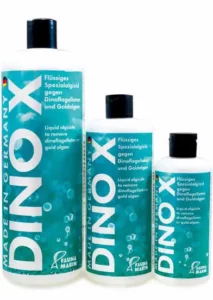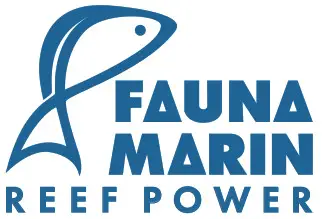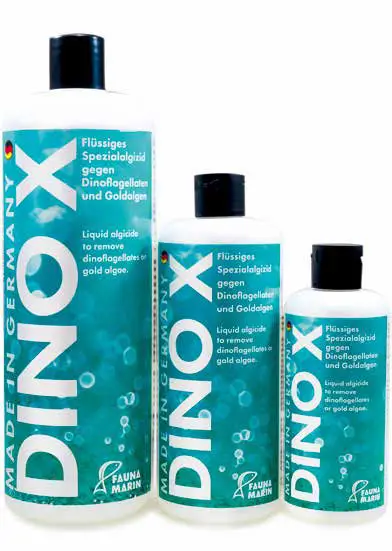
MARIN DINO X
Instructions
INSTRUCTIONS FOR USE
FAUNA MARIN
DINO X
Liquid algicide to remove dinoflagellates or gold algae

FAUNA MARIN DINO X

Dinoflagellates
There is hardly a seawater aquarist who does not know these pests. The dinoflagellate infestation of a reef tank is a nightmare, and most aquarists do not know how to deal with it. This HTU is intended to explain the necessary steps and to simplify the application of the DINO X product, making it as safe as possible. With this HTU you get your dino plague under control.
What are dinoflagellates?
Dinoflagellates are a group of unicellular algae, which also includes, for example, zooxanthellae, which our corals have as symbionts in their tissue. They are part of the reef‘s biocoenosis, and most species are harmless and travel as plankton in seawater.
In total, about 2,500 dinoflagellate species are known. In a saltwater aquarium, we are usually dealing with species from five genera. Depending on the species, the countermeasures should be adapted, and the cause of dinoflagellate proliferation may also be different. The diagnosis is therefore the first step to take the right measures and to be able to solve the problem (see HTU dinoflagellates).
FAUNA MARIN DINO X
DINO X is a special preparation to combat dinoflagellate and golden algae infections in reef aquaria. The preparation targets the metabolism of dinoflagellates and prevents the absorption of nutrients. These algae die in the process.
DINO X inhibits in principle all types of algae and is harmless to all species of bacteria! It has been specifically developed for use in marine aquaria and should not be used in aquaculture systems or on animals respectively plants intended for food production.
DINO X is not effective against cyanobacteria. DINO X is particularly effective against dinoflagellates. In any case, we recommend that you make an accurate diagnosis of the algae type before considering treatment with DINO X. If you stick to the recommended dosage exactly, there are usually no or only a few side effects.

Possible side effects
When using DINO X, in rare cases some problems may occur, which are listed below! Please follow our general instructions and the dosage instructions very carefully.
- Decrease of redox value and a slight decrease of pH value
- Sea urchins and other echinoderms, sea hares (e.g. Aplysia and Dolabella), and other herbivores could be damaged and should therefore be temporarily removed from the tank before treatment begins.
- Higher algae can also be damaged. You should therefore also remove them from the tank before starting treatment.
- Giant clams (Tridacna, Hippopus) and also some sea sponges can suffer slight damage. For this reason, you should also accommodate them elsewhere during the treatment to be on the safe side.
If the tank is heavily infested with algae, the water may become cloudy the first time you use it. This occurs rarely and can be reduced by prior siphoning out algae covers.
Toxin release from decreasing algae
Some of the algae occurring in the aquarium can release toxins when they decay. This is one of the reasons why it is so important to remove as many algae covers as possible before starting treatment. The less of it decomposes in the aquarium, the less the accompanying symptoms due to toxin release. Particularly aggressive and rapidly propagating dinoflagellates release toxins that can damage corals and other invertebrates.
DINO X should always be dosed in the evening or one hour after switching off the main light because then the zooxanthellae cease their photosynthesis activity and the effect of the product is optimal.
Dosage
5 ml DINO X per 100 l (26 US gal.) aquarium water
It is very important that you calculate the volume of your aquarium as accurately as possible. This is the only way to ensure that you avoid under-or overdosing. In case of very heavy infestation and good skimming, you can increase the dosage up to 6 ml/100 l (26 US gal.).
It is not possible to give a general indication of the duration of treatment because it depends on the type of algae concerned and the severity of the infestation. Repeat the dosage every other day until the algae have completely withdrawn. Dinoflagellates usually disappear after 10 –15 dosing cycles (20 – 30 days).
Please note the following instructions
- Limit the main lighting phase to a maximum of six 6 hours a day.
- Run the skimmer at full power, of course around the clock (24 / 7)
- Do not carry out partial water changes during the entire treatment! First partial water change one week after the end of dosing.
- No addition of trace elements during the treatment! Also no addition of mineral salts, amino preparations, or SPS floating feed. Supply systems such as the Balling-Light system will, however, be continued.
- Do not use ozone or activated carbon during the treatment!
- Do not use any adsorber filter materials during the treatment. After completion of the treatment, you should use Fauna Marin CARB L activated carbon, according to the recommended dosage.

- Relevant water values can be set with Balling, Balling light, or Kalkwasser. These have no effect on DINO X.
- Have an ICP test every week to ensure that the water values are adjusted correctly.
Tips and tricks for treatment
- Increase the water temperature to 28 – 29 °C.
- Install a UV-C sterilizer directly to the tank and channel the outlet water through nylon filter floss, which is changed daily.
- Switch off the light for two days at the beginning of the treatment.
- Install a silicate filter to prevent silicic acid from entering the aquarium.
- Siphon away algae covers regularly.
- Pay attention to water values and perform an ICP test. Pay particular attention to the nutrient situation and set the nutrients to a ratio of 1:100 phosphate/nitrate.
- Pay attention to the concentration of the halogens iodine/fluorine and bromine and their ratio to each other. A deficiency of these elements promotes dinoflagellate infection.
- Pay attention to the Dynamic Elements zinc, nickel, copper, vanadium, and molybdenum. Set these elements to the reference values.
